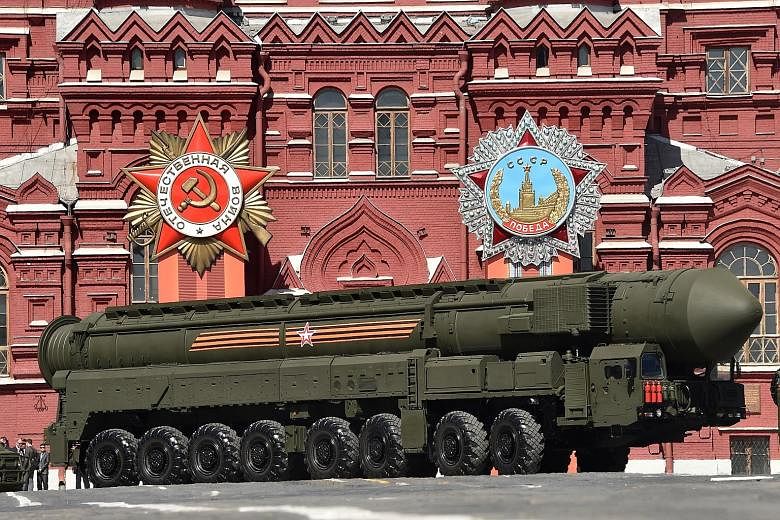NEW YORK • The United States, Russia and China are aggressively pursuing a new generation of smaller, less destructive nuclear weapons.
The build-ups threaten to revive a Cold War-era arms race and unsettle the balance of destructive force among nations that has kept the nuclear peace for more than half a century.
It is, in large measure, an old dynamic playing out in a new form as an economically declining Russia, a rising China and an uncertain US resume their one-upmanship.
US officials largely blame Russian President Vladimir Putin, saying his intransigence has stymied efforts to build on a 2010 arms control treaty and further shrink the arsenals of the two largest nuclear powers.
Some blame the Chinese, who are looking for a technological edge to keep the US at bay. And some blame the US itself for speeding ahead with a nuclear "modernisation" that, in the name of improving safety and reliability, risks throwing fuel on the fire.
US President Barack Obama acknowledged that danger at the end of the Nuclear Security Summit meeting in Washington early this month. He warned of the potential for "ramping up new and more deadly and more effective systems that end up leading to a whole new escalation of the arms race".
For a president who came to office more than seven years ago talking about eventually ridding the world of nuclear weapons, it was an admission that a US policy intended to reduce the centrality of atomic arms might contribute to a second nuclear age.
One of the few veterans of the Cold War in his administration, National Intelligence director James Clapper, told the Senate Armed Services Committee during his annual global threat assessment: "We could be into another Cold War-like spiral."
Adversaries look at what the US expects to spend on the nuclear revitalisation programme - estimated at up to US$1 trillion (S$1.36 trillion) over three decades - and use it to lobby for their own sophisticated weaponry.
Moscow is fielding big missiles topped by miniaturised warheads and experts fear that it may violate the global test ban as it develops new weapons. According to Russian news reports, the Russian navy is developing an undersea drone meant to loft a cloud of radioactive contamination from an underwater explosion that would make target cities uninhabitable.
The Chinese military, under the tighter control of President Xi Jinping, is flight-testing a novel warhead called a "hypersonic glide vehicle". It flies into space on a traditional long-range missile but then manoeuvres through the atmosphere, twisting and careening at over 1.6km a second. That can render missile defences all but useless.
The Obama administration is hardly in a position to complain. It is flight-testing its own hypersonic weapon, but an experiment in 2014 ended in a spectacular fireball. Flight tests are set to resume next year. As part of the modernisation process, it is also planning five classes of improved nuclear arms and associated delivery vehicles that, as a family, are shifting the US arsenal in the direction of small, stealthy and precise.
One fear about the new weapons is that they could undercut the grim logic of "mutual assured destruction", the Cold War doctrine that any attack would result in massive retaliation and ultimately the annihilation of all combatants. While much debated and often mocked - in classic movies such as Dr Strangelove - the doctrine worked.
Now, the concern is that the precision and less destructive nature of these new weapons raises the temptation to use them.
NEW YORK TIMES

